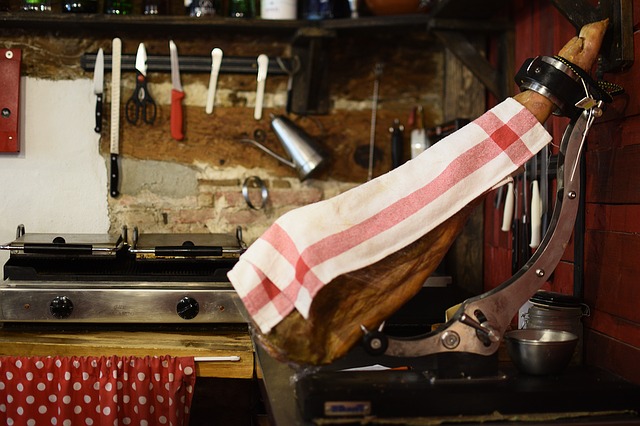In the 1992 melodrama Jamón Jamón a lovers’ quarrel turns violent. Class tensions drive the conflict. Jose Luis’ (Jorge Molla) parents own a factory. He falls in love with one of the workers, Silvia (Penelope Cruz), and gets her pregnant. His parents reject their plan for marriage and hire the fit, sexy Raul (Javier Bardem) to seduce the young woman. Raul sells jamón, with dreams of bullfighting and underwear modeling. In a spate of anger, Jose Luis arrives in Raul’s trailer with a club in hand. Legs of jamón hang from the ceiling. To defend himself, Raul grabs one of the hams and uses it as a weapon. Jose Luis meets a slick, salty end.
The film retains its Spanish-language title in its American release, with a parenthetical (Ham & Ham). Jamón Jamón evokes something aromatic, sensuous. The legs of ham that hang from the ceiling in Raul’s shop are lithe and firm. The translated title Ham & Ham highlights the campy humor of the movie, but misses on the sex appeal. The image conjured is not of golden and burgundy cured meat and fat, but of the pink, clove-studded, maple-glazed behemoths featured at holiday feasts or Easter brunch. It’s more Jaime Lee Curtis than Javier Bardem. The French Jambon Jambon hardly fairs better, rousing images of the boulangerie staple: le parisien, two slices of cooked ham sandwiched between a half a baguette, slathered with butter.
Why such divergent associations of jamón, jambon, and ham? Each product comes from same part of a pig: the upper hind leg where thigh becomes rear. The consensus ends there.
Jamón is the most specific term—it refers to a cured ham product. Two major categories of jamón appear often: Serrano and Iberico de Bellota. To carry the Iberico de Bellota name, producers exclusively use the hams of acorn-fed, free-range black hoof (pata negra) pigs. Serrano ham is made from a different breed of white pigs. The production for both products follows the same basic steps. It begins as a raw piece of meat, traditionally with the leg bone and hoof still attached. Much of the skin is removed. This allows the meat to breathe during the aging process. The raw hams are submerged in sea salt and then hung to stabilize, then relocated to a drying room. Its environment may be regulated the old fashioned way: by opening and closing windows.
Both jambon and ham require qualifiers. Any grocery store in France carries at least six types of jambon: cru, cuit, de Paris, de campagne, de pays, de Bayonne. The first two adjectives, cru and cuit (raw, cooked) separate these varieties. None of these are raw in the fresh pork chop sense: jambon cru refers to a cured product. The pork is raw in that it has not been cooked, but has been subject to other transformative processes that render it edible. Jambon de Bayonne and jambon de pays are cured. Jambon de Paris is a boiled, boneless ham. Sliced, it makes the le parisien what it is. Jambon de Campagne refers to both cooked and cured hams, depending on context and provenance.
Ham in American English is much the same, the distinction drawn between two categories: “city” and “country” ham. City ham—much more available in the United States—is cooked while country ham is cured. The curing process for American-style country ham involves more ingredients than either the French or Spanish varieties. A blend of sugar and spices accompanies the necessary salt bath. Regions have their specific recipes; Virginia in particular has a long history of producing country hams.
City ham is made by first soaking the pork brine bath to plump up the meat. Often, this process is accelerated in industrial meat processing: the hams receive a direct injection of brine, rather than languishing in a salty bath for a few weeks. After brining, the hams hang in a smoker for somewhere between twelve and twenty-four hours. They are cooked during the smoking process and ready to eat as-is, whether thick cut and fried, sliced onto a sandwich, or roasted into the ubiquitous glazed holiday ham.
In the Spanish original Jamón Jamón brings to mind the wonder of natural processes, the infallibility of salt and time. It condenses a clear tradition and history into the repetition. There are no questions to ask. There is nothing boiled or brined or honey-glazed, just the promise of rich flavor and effective self-defense.
***
Read more about Food:

